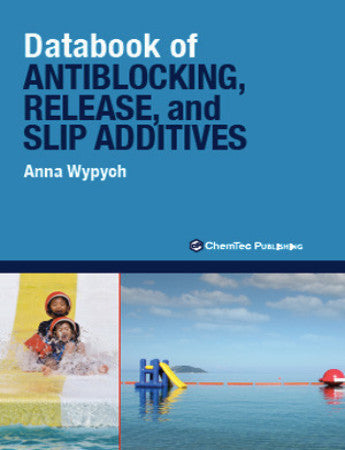Databook of Antiblocking, Release, and Slip Additives
Databook of Antiblocking, Release, and Slip Additives contains data on over 300 the most important additives. Its structure has 145 data fields to accommodate a variety of data available in source publications. The description of general sections below gives more detail on the composition of information. The additive databook is divided into five sections: General information, Physical properties, Health and safety, Ecological properties, and Use & Performance and contains any of the listed below data if they are available for a particular compound.
In General information section the following data are included: name, CAS #, IUPAC name, Common name, Common synonyms, Acronym, Empirical formula, Molecular weight, Chemical class, Mixture, Alkyl distribution, Primary amine concentration, Product contents, Free acid, Amine number, Moisture content, Silicone content, and Solids content .
Physical section contains data on State, Odor, Color (Gardner and Platinum-cobalt scales), Boiling point, Melting point, Freezing point, Pour point, Cloud point, Dropping point, Iodine Value, Particle hardness, Particles size, Surface area (BET), Refractive index, Specific gravity, Density, Bulk density, Vapor pressure, pH, Saponification value, Acidity, Viscosity, Kinematic viscosity, Melt index, Surface tension, Solubility in water and solvents, Thermal expansion coefficient, Heat of combustion, Specific heat, Thermal conductivity, Volatility, Coefficient of friction, Volume resistivity, Dielectric constant, and Ash contents.
Health and safety section contains data on ADR /RID Class, Flash point, Flash Point Method, Autoignition temperature, Explosive LEL, Explosive UEL, NFPA Classification, NFPA Health, NFPA Flammability, NFPA Reactivity, WHMIS Classification, HMIS Health, HMIS Fire, HMIS Reactivity, HMIS Personal protection, OSHA Hazard Class, EINECS number, EC number, UN Risk Phrases, R, UN Safety Phrases, S, DOT Hazard Class, UN/NA, ICAO/IATA Class, IMDG Class, TDG class, Proper shipping name, Rat oral LD50, Mouse oral LD50, Rabbit dermal LD50, Inhalation rat, LC50, Skin irritation, Eye irritation (human), Carcinogenicity, Teratogenicity, Mutagenicity, and TLV - TWA 8h (ACGIH, NIOSH, OSHA).
Ecological properties section contains data on Biological Oxygen Demand, Theoretical Oxygen Demand, Biodegradation probability, Aquatic toxicity LC50 (rainbow trout, bluegill sunfish, fathead minnow, daphnia magna), and Partition coefficients (log Koc, log Kow).
Use & performance section contains information on Manufacturer, Outstanding properties, Recommended for general applications, Recommended for polymers, Recommended for products, Features & benefits, Recommended processing method, Recommended mold material, Additive type, Additive application method, Recommended dosage, Post-processing, Food law approvals, Coefficient of friction at 1000 ppm, Release force, and Davies scale.
In General information section the following data are included: name, CAS #, IUPAC name, Common name, Common synonyms, Acronym, Empirical formula, Molecular weight, Chemical class, Mixture, Alkyl distribution, Primary amine concentration, Product contents, Free acid, Amine number, Moisture content, Silicone content, and Solids content .
Physical section contains data on State, Odor, Color (Gardner and Platinum-cobalt scales), Boiling point, Melting point, Freezing point, Pour point, Cloud point, Dropping point, Iodine Value, Particle hardness, Particles size, Surface area (BET), Refractive index, Specific gravity, Density, Bulk density, Vapor pressure, pH, Saponification value, Acidity, Viscosity, Kinematic viscosity, Melt index, Surface tension, Solubility in water and solvents, Thermal expansion coefficient, Heat of combustion, Specific heat, Thermal conductivity, Volatility, Coefficient of friction, Volume resistivity, Dielectric constant, and Ash contents.
Health and safety section contains data on ADR /RID Class, Flash point, Flash Point Method, Autoignition temperature, Explosive LEL, Explosive UEL, NFPA Classification, NFPA Health, NFPA Flammability, NFPA Reactivity, WHMIS Classification, HMIS Health, HMIS Fire, HMIS Reactivity, HMIS Personal protection, OSHA Hazard Class, EINECS number, EC number, UN Risk Phrases, R, UN Safety Phrases, S, DOT Hazard Class, UN/NA, ICAO/IATA Class, IMDG Class, TDG class, Proper shipping name, Rat oral LD50, Mouse oral LD50, Rabbit dermal LD50, Inhalation rat, LC50, Skin irritation, Eye irritation (human), Carcinogenicity, Teratogenicity, Mutagenicity, and TLV - TWA 8h (ACGIH, NIOSH, OSHA).
Ecological properties section contains data on Biological Oxygen Demand, Theoretical Oxygen Demand, Biodegradation probability, Aquatic toxicity LC50 (rainbow trout, bluegill sunfish, fathead minnow, daphnia magna), and Partition coefficients (log Koc, log Kow).
Use & performance section contains information on Manufacturer, Outstanding properties, Recommended for general applications, Recommended for polymers, Recommended for products, Features & benefits, Recommended processing method, Recommended mold material, Additive type, Additive application method, Recommended dosage, Post-processing, Food law approvals, Coefficient of friction at 1000 ppm, Release force, and Davies scale.
1 Introduction
2 Information on data fields
3 Antiblocking agents
3.1 Inorganic
3.1.1 Calcium carbonate
3.1.2 Synthetic silica
3.1.3 Synthetic clay (laponite)
3.1.4 Talc
3.1.5 Other
3.2 Organic
3.2.1 Microparticles
3.2.2 Fatty acid amides
3.2.3 Polymers and waxes
3.2.4 Other
4 Release agents
4.1 Fluorocompounds
4.2 Silicone polymers
4.3 Other polymeric compounds
4.4 Other chemical compounds
5 Slip agents
5.1 Acids
5.2 Esters
5.3 Fatty acid amides
5.4 Natural wax and its substitutes
5.5 Salts
5.6 Others
2 Information on data fields
3 Antiblocking agents
3.1 Inorganic
3.1.1 Calcium carbonate
3.1.2 Synthetic silica
3.1.3 Synthetic clay (laponite)
3.1.4 Talc
3.1.5 Other
3.2 Organic
3.2.1 Microparticles
3.2.2 Fatty acid amides
3.2.3 Polymers and waxes
3.2.4 Other
4 Release agents
4.1 Fluorocompounds
4.2 Silicone polymers
4.3 Other polymeric compounds
4.4 Other chemical compounds
5 Slip agents
5.1 Acids
5.2 Esters
5.3 Fatty acid amides
5.4 Natural wax and its substitutes
5.5 Salts
5.6 Others
Anna Wypych, born in 1937, studied chemical engineering and polymer chemistry and obtained M. Sc. in chemical engineering in 1960. The professional expertise includes both teaching and research & development. Anna Wypych has published 1 book (MSDS Manual), several databases, 6 scientific papers, and obtained 3 patents. She specializes in polymer additives for PVC and other polymers and evaluates their effect on health and environment.




